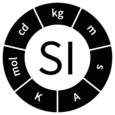Newton (unit)
| newton | |
|---|---|
Sir Isaac Newton | |
| Conversions | |
| 1 N in ... | ... is equal to ... |
| SI base units | 1 kg⋅m⋅s−2 |
| CGS units | 105 dyn |
| Imperial units | 0.224809 lbf |
The newton (symbol: N) is the unit of force in the International System of Units (SI). It is defined as , the force which gives a mass of 1 kilogram an acceleration of 1 metre per second squared.
It is named after Isaac Newton in recognition of his work on classical mechanics, specifically his second law of motion.
Definition
A newton is defined as (it is a named derived unit defined in terms of the SI base units).[1]: 137 One newton is, therefore, the force needed to accelerate one kilogram of mass at the rate of one metre per second squared in the direction of the applied force.[2]
The units "metre per second squared" can be understood as measuring a rate of change in velocity per unit of time, i.e. an increase in velocity by 1 metre per second every second.[2]
In 1946, the
The newton is named after
The connection to Newton comes from Newton's second law of motion, which states that the force exerted on an object is directly proportional to the acceleration hence acquired by that object, thus:[5]
Examples
At average gravity on Earth (conventionally, ), a kilogram mass exerts a force of about 9.8 newtons.
- An average-sized apple at 200 g exerts about two newtons of force at Earth's surface, which we measure as the apple's weight on Earth.
- An average adult exerts a force of about 608 N on Earth.
- (where 62 kg is the world average adult mass).[6]
Kilonewtons

Large forces may be expressed in kilonewtons (kN), where 1 kN = 1000 N. For example, the tractive effort of a Class Y steam train locomotive and the thrust of an F100 jet engine are both around 130 kN.[citation needed]
Climbing ropes are tested by assuming a human can withstand a fall that creates 12 kN of force. The ropes must not break when tested against 5 such falls.[7]: 11
Conversion factors
| newton | dyne | kilogram-force, kilopond |
pound-force | poundal | |
|---|---|---|---|---|---|
| 1 N | ≡ 1 kg⋅m/s2 | = 105 dyn | ≈ 0.10197 kp | ≈ 0.22481 lbf | ≈ 7.2330 pdl |
| 1 dyn | = 10–5 N | ≡ 1 g⋅cm/s2 | ≈ 1.0197×10−6 kp | ≈ 2.2481×10−6 lbf | ≈ 7.2330×10−5 pdl |
| 1 kp | = 9.80665 N | = 980665 dyn | ≡ gn × 1 kg | ≈ 2.2046 lbf | ≈ 70.932 pdl |
| 1 lbf | ≈ 4.448222 N | ≈ 444822 dyn | ≈ 0.45359 kp | ≡ gn × 1 lb | ≈ 32.174 pdl |
| 1 pdl | ≈ 0.138255 N | ≈ 13825 dyn | ≈ 0.014098 kp | ≈ 0.031081 lbf | ≡ 1 lb⋅ft/s2 |
| The value of gn as used in the official definition of the kilogram-force (9.80665 m/s2) is used here for all gravitational units. | |||||
| Base | Force | Weight | Mass | |||||
|---|---|---|---|---|---|---|---|---|
| 2nd law of motion | m = F/a | F = W ⋅ a/g | F = m ⋅ a | |||||
| System | BG |
GM | EE | M | AE |
CGS | MTS | SI |
| Acceleration (a) | ft/s2 | m/s2 | ft/s2 | m/s2 | ft/s2 | Gal | m/s2 | m/s2 |
| Mass (m) | slug | hyl
|
pound-mass | kilogram | pound | gram | tonne | kilogram |
| Force (F), weight (W) |
pound | kilopond
|
pound-force | kilopond | poundal | dyne | sthène | newton |
| Pressure (p) | pound per square inch | technical atmosphere
|
pound-force per square inch | standard atmosphere | poundal per square foot | barye | pieze |
pascal |
| Prefix name | N/A | deca | hecto | kilo | mega | giga | tera
|
peta
|
exa
|
zetta
|
yotta
|
ronna
|
quetta
|
|---|---|---|---|---|---|---|---|---|---|---|---|---|---|
| Prefix symbol | da | h | k | M | G | T | P | E | Z | Y | R | Q | |
| Factor | 100 | 101 | 102 | 103 | 106 | 109 | 1012 | 1015 | 1018 | 1021 | 1024 | 1027 | 1030 |
| Prefix name | N/A | deci | centi | milli | micro | nano | pico
|
femto
|
atto
|
zepto
|
yocto
|
ronto
|
quecto
|
|---|---|---|---|---|---|---|---|---|---|---|---|---|---|
| Prefix symbol | d | c | m | μ | n | p | f | a | z | y | r | q | |
| Factor | 100 | 10−1 | 10−2 | 10−3 | 10−6 | 10−9 | 10−12 | 10−15 | 10−18 | 10−21 | 10−24 | 10−27 | 10−30 |
See also
- Force gauge
- International System of Units (SI)
- Joule, SI unit of energy, 1 newton exerted over a distance of 1 metre
- Kilogram-force, force exerted by Earth's gravity at sea level on one kilogram of mass
- Kip (unit)
- Pascal, SI unit of pressure, 1 newton acting on an area of 1 square metre
- Orders of magnitude (force)
- Pound (force)
- Sthène
- Newton metre, SI unit of torque
References
- Bureau International des Poids et Mesures (BIPM). p. 137. Archivedfrom the original on 30 September 2021. Retrieved 22 September 2021.
- ^ a b "Newton | unit of measurement". Encyclopædia Britannica. 17 December 2020. Archived from the original on 27 September 2019. Retrieved 27 September 2019.
- ^ ISBN 9282220451. Archived from the originalon 11 May 2016. Retrieved 15 November 2015.
- ^ David B. Newell; Eite Tiesinga, eds. (2019). The International System of Units (SI) (PDF) (NIST Special publication 330, 2019 ed.). Gaithersburg, MD: NIST. Retrieved 30 November 2019.
- ^ "Table 3. Coherent derived units in the SI with special names and symbols". The International System of Units (SI). International Bureau of Weights and Measures. 2006. Archived from the original on 18 June 2007.
- PMID 22709383.
- ^ Bright, Casandra Marie. "A History of Rock Climbing Gear Technology and Standards." (2014).
- .
- .













